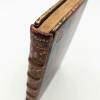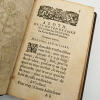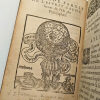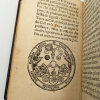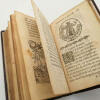BASILE VALENTIN
Azoth ou le moyen de faire l’or caché des philosophes
Azoth ou le moyen de faire l’or caché des philosophes. De Frère Basile Valentin À Paris, chez Pierre Moet. 1659 Petit In-8 de 172x112mm de 196pp. Frontispice, nombreux bandeaux et lettrines, 14 bois gravés. Reliure plein veau rouge du XVIIeme à 5 nerfs. Pièce de titre et caissons dorés, roulette dorée sur les nerfs. Plats décorés d’encadrements dorés et fleurons dorés. Roulette dorée sur les bords des plats. Gardes blanches. “Heureux trois voire quatre fois, heureux celui qui a acquis l’entière connoissance de cet art” Basile Valentin Écrit par Basile Valentin, célèbre chanoine alchimiste du XVIeme siècle, ce livre est une référence dans l’alchimie philosophique. Loin des livres ésotériques folkloriques, il nous ouvre les voies de la sagesse de la vie. La première partie consiste en un dialogue entre Adolphe, représentant celui qui croit savoir, matérialiste attiré par la richesse mais ayant soif d’apprendre et le Vieillard, le philosophe, simple d’apparence, dont les discours paraissent naïfs si l’on ne sait en déchiffrer les métaphores. “Tu repousseras les ténèbres & toute obscurité & aveuglement car c’est la force des forces qui surmonte toute force et chose subtiles & pénètre les choses dures & solides.” B.V. La seconde partie, nous livre les secrets de concepts alchimiques mystérieux, au travers de la pierre philosophale, l’Azoth, le Mercure, le VITRIOL ou le Dragon, un ensemble de clés métaphoriques nous ouvrant les secrets de la vie au travers du principe de transmutation (parfois appelé Remède Universel ou Panacée). “Je suis Dragon envenimé étant partout présent et à vil prix, la chose sur laquelle je repose et qui se repose sur moi, se trouvera en moi, qui recherchera bien et diligemment mon eau & mon feu destructeur et composeur [...] les philosophes me nomment Mercure, mon mari est l’or philosophique, je suis le vieux Dragon présent par toute la terre, je suis père et mère, jeune et vieux, fort & débile, dur et mou, descendant en terre et montant au ciel, très grand et très petit, très léger et très pesant.” B.V. La seconde partie est structurée comme suit : 1 Atlas 2 Les paroles d’Hermès au pimandre 3 La Table Smaragdine d’Hermès ou les paroles des secrets d’Hermès 4 Le symbole de frère Basile Valentin 5 Le symbole nouveau 6 Matière première 7 Opération du mystère philosophique 8 Figure seconde 9 Figure troisième 10 Figure quatrième 11 Cinquième figure 12 Figure sixième 13 L’œuvre universelle des philosophes 14 Déclaration et explication d’Adolphe 15 Le symbole de Saturne La troisième partie est un poème philosophique sur l’Azoth des philosophes. Si le texte semble avoir plusieurs niveaux de lecture, il est, plus prosaïquement, et malgré les coquilles, très bien écrit, d’une grande poésie. “Ceci est vrai et éloigné de tout mensonge que ce qui est dessous est semblable à ce qui est dessus [...] le Soleil est le Père & la Lune est la Mère, le vent la porte en son ventre, la terre est sa nourrice, la mère de toute perfection, sa puissance est parfaite si elle est changée en Terre, séparez la terre du feu, le subtil d’avec l’espois & gros, et prudemment avec modestie et sagesse il monte de la terre au ciel [...] par ce moyen vous aurez la gloire de tout.” B.V. Basil Valentin (Basilius Valentinus) est un des grands noms de l’alchimie, présenté comme un moine bénédictin qui aurait vécu au prieuré de Saint-Pierre à Erfurt, si son existence reste énigmatique, la majorité des ouvrages qui lui sont attribués ont été publiés au début du XVIIe siècle. Ses œuvres présentent pour la première fois les grands principes de l’alchimie ou proto-chimie comme la production d’ammoniac, d'acide chlorhydrique ou d'acide sulfurique et a contribué à la notoriété de l’Azoth ou du Vitriol. Basile Valentin semblerait être un pseudonyme Johann Thölde. Caillet 797; Brunet V, 1035 Pernety 52 État : bonne condition de la reliure, patinée avec le temps, les décorations dorées sont très bien conservées, annotations et traits de crayon de papier, petite tache entre les pages 15 à 41 en bas de page, taches page 81, salissures. Nombreuses erreurs de pagination à l’impression, le livre est bien complet. Dans l’ensemble, très bon état (voir photos). “Ainsi soit-il au Mercure, lequel bien qu’il soit sans pieds court, comme l’eau, ne mouillant les mains et opère tout métaliquement.” B.V. ---------------------------------------------- Azoth ou le moyen de faire l’or caché des philosophes. De Frère Basile Valentin À Paris, chez Pierre Moet. 1659 Small octavo, 172x112mm, 196pp. Frontispiece, numerous headbands and initials, 14 woodcuts. 17th-century full red calf binding with five raised bands. Gilt title label and compartments, gilt border on the raised bands. Covers decorated with gilt frames and gilt fleurons. Gilt border on the edges of the covers. Blank endpapers. “Happy three or even four times, happy is he who has acquired the complete knowledge of this art.” Basile Valentin Written by Basile Valentin, a famous 16th-century alchemist canon, this book is a reference in philosophical alchemy. Far from folkloric esoteric books, it opens the paths to the wisdom of life. The first part consists of a dialogue between Adolphe, representing the one who believes he knows, a materialist attracted by wealth but thirsty for knowledge, and the Old Man, the philosopher, simple in appearance, whose speeches seem naive if one cannot decipher their metaphors. “You will repel darkness, all gloom, and blindness, for it is the force of forces that overcomes all force and subtle things and penetrates hard and solid things.” B.V. The second part reveals the secrets of mysterious alchemical concepts through the Philosopher's Stone, Azoth, Mercury, VITRIOL, or the Dragon, a set of metaphorical keys that unlock the secrets of life through the principle of transmutation (sometimes called the Universal Remedy or Panacea). “I am a poisonous Dragon, being everywhere present and at a low price, the thing on which I rest and which rests on me, will be found in me, which will seek well and diligently my water & my destructive and composing fire [...] the philosophers call me Mercury, my husband is the philosophical gold, I am the old Dragon present throughout the earth, I am father and mother, young and old, strong & weak, hard and soft, descending to earth and ascending to heaven, very large and very small, very light and very heavy.” B.V. The second part is structured as follows: 1 Atlas 2 The Words of Hermes to the Pimander 3 The Smaragdine Table of Hermes or the Words of the Secrets of Hermes 4 The Symbol of Brother Basil Valentine 5 The New Symbol 6 Raw Material 7 Operation of the Philosophical Mystery 8 Second Figure 9 Third Figure 10 Fourth Figure 11 Fifth Figure 12 Sixth Figure 13 The Universal Work of the Philosophers 14 Declaration and Explanation of Adolphe 15 The Symbol of Saturn The third part is a philosophical poem on the Azoth of the philosophers. While the text appears to have several levels of interpretation, it is, more prosaically, and despite the typos, very well written and highly poetic. “This is true and far from any lie, that what is below is similar to what is above [...] the Sun is the Father and the Moon is the Mother, the wind carries it in its womb, the earth is its nurse, the mother of all perfection, its power is perfect if it is changed into Earth, separate the earth from the fire, the subtle from the hope and gross, and prudently, with modesty and wisdom, it rises from the earth to the sky [...] by this means you will have the glory of all.” B.V. Basil Valentinus (Basilius Valentinus) is one of the great names in alchemy, presented as a Benedictine monk who lived at the Priory of Saint Peter in Erfurt. While his existence remains enigmatic, the majority of the works attributed to him were published in the early 17th century. His works presented for the first time the major principles of alchemy or protochemistry, such as the production of ammonia, hydrochloric acid, and sulfuric acid, and contributed to the fame of Azoth and Vitriol. Bassie Valentin appears to be a pseudonym for Johann Thölde. Caillet 797; Brunet V, 1035 Pernety 52 Condition: Binding in good condition, patinated with age. The gilt decorations are very well preserved. annotations and pencil marks are present. There is a small stain between pages 15 and 41 at the bottom of the page. There are stains on page 81. There are numerous printing errors. The book is complete. Overall, very good condition (see photos). “So be it to Mercury, which, although it is footless, runs like water, not wetting the hands and operates entirely metallically.” B.V.
Reference : ASF-23
Bookseller's contact details
Librairie Casaubon
Deshayes
Payment mode
Sale conditions
Nos conditions sont conformes aux usages de la librairie ancienne et moderne. Les prix sont nets et s'entendent en €. Frais de port (recommandé) à la charge du client. Envoi uniquement après paiement. Assurance à la charge du client. Commandes : Les commandes sont validées après réception du paiement intégral. Paiements acceptés : Carte bancaire, virement bancaire. Prix : Les prix sont affichés en euros, toutes taxes comprises. Les frais de livraison sont indiqués séparément avant le paiement. Disponibilité : En cas d’indisponibilité d’un article après validation de la commande, le Client sera remboursé ou pourra choisir un article de remplacement. Réserve de propriété : Les articles restent la propriété de Casaubon Livres Rares jusqu’à paiement complet. Zones desservies : Europe Asie et Amérique du Nord. Frais de livraison : Calculés en fonction du poids des articles et de la destination. Les frais sont détaillés lors de la validation de la commande. Délais de livraison : Europe : 5 à 10 jours ouvrables. Amérique du Nord : 10 à 15 jours ouvrables. Ces délais sont indicatifs et peuvent varier selon les transporteurs.
 Write to the booksellers
Write to the booksellers
